Deep Sky Observations with ZWO ASI224MC 2021
Conditions | Observation Overview | Overview of the Observed Sky Objects | Remarks | References
At the beginning of April 2021, I borrowed a ZWO ASI224MC from a starfriend. This camera has the same Sony sensor as my eVscope, which was one reason to borrow the camera and try it out on my various telescope tubes. The other one was that I was not satisfied with my Atik Infinity camera after several tests in early 2021, especially with its sensitivity. It was said that modern CMOS cameras are more sensitive than CCD cameras like the Atik Infinity, which in turn is said to have better dynamic range. Reasons enough to test this camera! The tests took place in April/May 2021; later tests were performed at the beginning of September and in November and in November 2021.
Update: I bought the ASI224MC from my starfriend on April 25, 2021 and I sold it again in mid-April 2022.
Conditions
Sky Region and Objects
I looked into different sky regions and at different times during the year, so a description does not make much sense here.
Overview Map
Since the observations will be separated through a long period of time, a sky map does not make much sense.
Observation Time
The observations started every day when it was sufficiently dark. This can be at quite different times in the course of the year.
Observation Location
All observations were conducted in Mühlhausen/Kraichgau (Germany):
- Coordinates: 49° 15′ N , 8° 43′ E
- Coordinates (dec.): 49,25° N, 8,72° E
Equipment Used
Camera, Laptop, GoTo Mount, Power Supply, Smartphone/Handbox
First of all, the ASI224MC camera is needed for taking photos. To operate the camera, a laptop on which the control application for the camera runs is also required; the laptop also powers the camera. And, of course, you need a GoTo mount and a power supply, typically a power tank. If you control the mount via app, you also need a smartphone (or a handbox, if you control the mount "by hand").
Software
Initially, I used the software ASILive to control the camera. Later, I used both, ASILive as well as SharpCap.
Telescope Tubes, Focal Reducer
Depending on the telescope tube used, focal length reducers must also be used. This is indicated for the respective observations.
PS 72/432
I bought the Omegon PS 73/432 ED refractor (432 mm, f/6) in September 2018, but used it only visually at the beginning. It took until the year 2021 that this changed. To be able to get into focus with the camera, I used the newly acquired T2 extension sleeves (Explore Scientific).
 |
 |
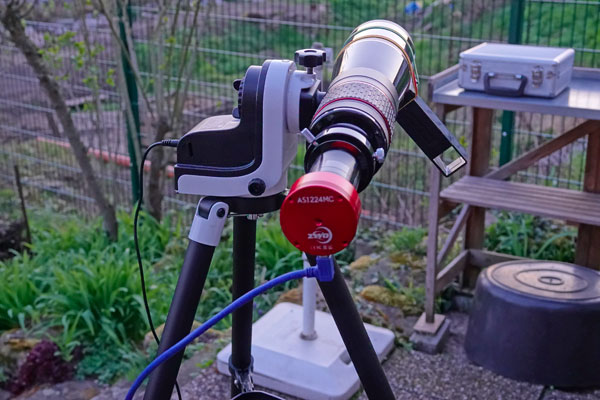 |
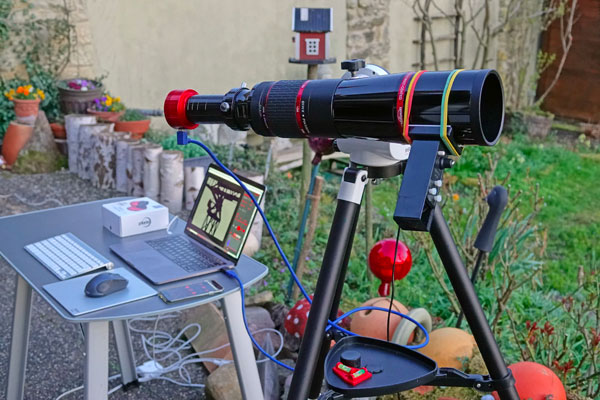 |
 |
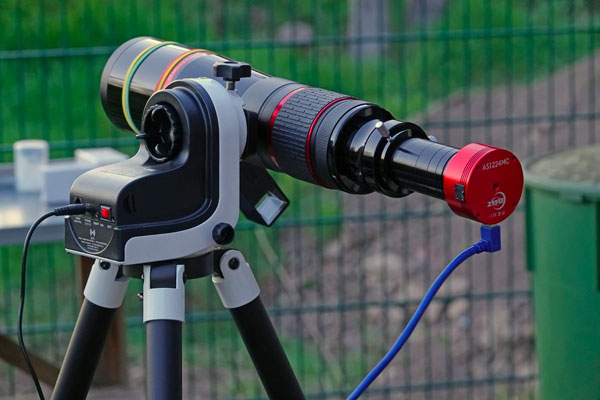 |
Photos: PS 72/432 with ASI224 camera (spring 2021)
C5
The C5 was an attempt to acquire a compact, versatile, and comparatively fast travel telescope, which can also be used as a "quick-and-dirty" telescope" and as a spotting scope. I bough it in December 2020.
TLAPO1027
With the TS-Optics TLAPO1027, I wanted to acquire a refractor with particularly pure colors, and which also has a wider aperture than my Omegon PS 72/432. I bought it in July 2020. This refractor also needs the extension tubes.
 |
 |
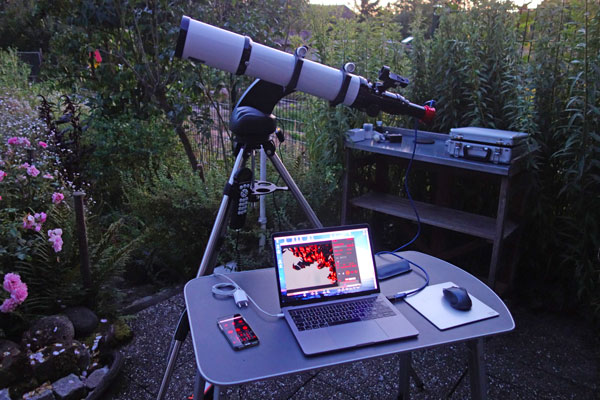 |
 |
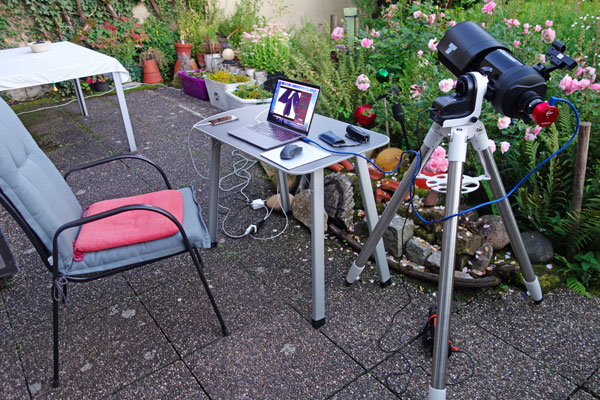 |
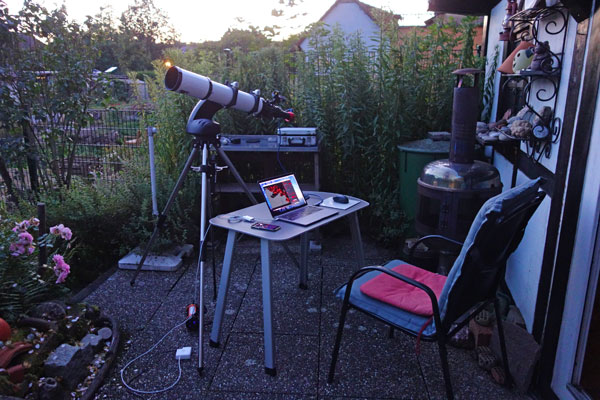 |
| PS 72/432 (upper photo from spring 2021) | C5 | TLAPO 1027 |
Photos: ASI224 in use at the three tubes PS 42/432, C5, and TLAPO1027 at the beginning of September 2021
General Conditions
In general, the sky above Mühlhausen/Kraichgau is "light-polluted" and does not invite you to search for deep sky objects. Cameras will find the objects even in worse conditions, but really good results are obtained only under dark skies.
Observation Overview
Observation Details
| Date 2021 |
Observed Objects | Further Observations and Remarks | Devices Used | Reducers Used | General Remarks |
| Apr 8 MH |
GN: M 42/43, M 78, NGC 2024 G: M 96 |
Order: M 42/43, NGC 2024, M 78, M 96 | PS 72/432 on AZ-GTi with ASI224MC | --- | 1-star alignment via SynScan app All in all, disappointing results. The stars where somewhat bloated. |
| Apr 12 MH |
Order: M 42/43, M 65/66, M 105 - without success and photos | C5 on AZ-GTi with ASI224MC | f/6,3 | 1-star alignment via SynScan app No results! |
|
| Apr 13 MH |
G: M 51, M 65, M 66, M 95, M 96, M 105, NGC 3628 | Order (PS72) : M 65/66 (both in the same FOV, NGC 3628, M 105 (together with NGC 3384 and NGC 3389), M 95, M 96, and M 51. Die Sterne waren wieder etwas aufgeblasen. | C5 and PS 72/432 on AZ-GTi with ASI224MC | f/6,3 (C5) | 1-star alignment via SynScan app No results with C5 (M 42/43, M 78), because the stacking did not work; disappointing results with PS72. Again, the stars where somewhat bloated. |
| Apr 20 MH |
G: M 51 | Only M 51 observed and photographed with and without UV/IR cut filter; half moon | PS 72/432 on AZ-GTi with ASI224MC; UV/IR cut filter | --- | Initially 1-star alignment via SynScan app with problems, then brightest-star alignment; tracking OK afterwards. The test with/without filter did not reveal, whether the stars are less blown up (focusing difficult) with the filter. Used ASILive and SharpCap, also tried darks; overall, rather a "disaster seesion" (e.g. colors in SharpCap). |
| Apr 23 MH |
G: M 51 | Only tests at M 51 with and without UV/IR cut filter | PS 72/432 on AZ-GTi with ASI224MC; UV/IR cut filter | --- | Used SharpCap and later ASILive to control the camera. Tested first how the tube has to be oriented (finder points down); used the Brightest Star alignment method; the tracking was "fairly OK" When using SharpCap, I now believe to have found an effect of the filter. Made three capture attempts; the second one was only brief and does not count; captured probably once with a filter (1), and once (3) without one... All in all, I got useable results. |
| Apr 24 MH |
G: M 51 | Only tests at M 51 | C5 on AZ-GTi with ASI224MC | f/6,3 | No usable photos because the stacking did not work. |
| May 8 MH |
Was not able to find a target | PS 72/432 on AZ-GTi with ASI224MC and UV/IR cut filter | --- | No photos; potentially the problems were cause by the camera hitting the tripod legs... Fell down the garden stairs... | |
| May 9 MH |
G: M 51 | Could not find M 51 again at first, but eventually it worked. | PS 72/432 on AZ-GTi with ASI224MC and UV/IR cut filter | --- | I used ASILive and SharpCap as well as the UV/IR cut filter. Took two captures with ASILive, each lasting 10 minutes; the first had poorer focus, the focus was better for the second one (no darkframes, automatic removal of hotpixels). When using SharpCap afterwards, the stacking did nor work, so no results (or better, just a poor one with 8 frames)... |
| Sep 2 MH |
KS: M 13, M 71, M 92 OS: M 11 PN: M 27, M 57 G: NGC 6041, NGC 7317 |
Order: M 13, M 92, M 51 (SQM 20), nebulae (M 20, 16, 17) did not work,
M 11, M 27, both misssed with GoTo access, M 57, Hercules Galaxy Cluster
(NGC 6041), Stephan's Quintet (NGC 7317), M 71 |
PS 72/432 on AZ-GTi with ASI224MC and UV/IR cut filter | --- | SQM 19.86, later always around 20... Observed from 9:30 p.m. until shortly
before 11:30 p.m.
SynScan app on iPhone, ASILive (hotpixel removal aktivated, no darkframes) |
| Sep 3 MH |
Jupiter, Saturn KS: M 13, M 92 PN: M 27 |
Order: M 13 (from 11:50 p.m. on), M 92, Jupiter with and without moons,
M 27, M 13, Saturn, Jupiter |
C5 on AZ-GTi with ASI224MC, later also with UV/IR cut filter | f/6.3 | SQM around 20.1... Observed from 10:00 p.m. on (took photos from 10:50
p.m. on) until about 0:30 a.m..
SynScan app on iPhone, ASILive (hotpixel removal aktivated, no darkframes) At the beginning NOTHING worked! I was successful only after I visually searched for the targets with the 32 mm eyepiece and then mounted the camera. Sometimes the target was already at least at the edge, sometimes not in the field of view at all; then it was necessary to search (which worked for the larger objects). Somehow I found most of them, M27 with much effort, though... I had problems with focusing! The focus points for the eyepiece and the camera were far apart, and I could not remember the direction of rotation... Cranked and cranked, and it did not focus... Finally, I got it right on all objects. |
| Sep 4 MH |
KS: M 13, M 92 OS: M 11 PN: M 27, M 57 GN: M 16, M 17, M 20 G: M 51 |
Order: M 13 (5s, 10s; with 10s I had initiually huge problems, later also with 5s at the begining; I had to perform a lot of stack restarts...), M 92 (had to help visually with the 32 mm eyepiece), M 51 (about 10 p.m., SQM 20), M 16 miserable tracking, M 17, M 20 (to low and sky tooo bright), M 11, M 27, M 57 (2s, 5s; washed out) | TLAPO1207 on Star Discovery with SynScan WLAN Module | --- | SQM around 20; observations began at about 9:10 p.m. and ended at
about 0:30 a.m..
SynScan app on iPhone, ASILive (hotpixel removal aktivated, no darkframes) I was able to find somehow most objects after the GoTo access. Only with M 92 I had to take the 32 mm eyepiece as a help. M 92 was pretty much in the middle with the eyepiece, but I still could not find it with the camera... In general, I often had to restart the stacks because the image was out of focus or the stacking did not work. The tracking of the mount seemed to be poor in parts. Often the black border grew with each new image, but sometimes it remained in place... |
| Nov 9 MH |
OC: M 2, M 15 | Order: M 2, M 15 | PS 72/432 on AZ-GTi with ASI224MC and UV/IR cut filter, StellarMate | f/6.3 | With StellarMate, GoTo with platesolving, photos only taken in"Live View" |
| Nov 18 MH |
Moon | Moon (full) | PS 72/432 on AZ-GTi with ASI224MC and UV/IR cut filter, StellarMate | f/6.3 | With StellarMate, moon manually accessed, photos only taken in"Live View" |
| Nov 23 MH |
OC: M 2, M 15 | Order: M 2, M 15 | PS 72/432 on AZ-GTi with ASI224MC and UV/IR cut filter, StellarMate | f/6.3 | With StellarMate, GoTo with platesolving, photos taken in "Live View" and with "Live Stacking" |
| Nov 27 MH |
Jupiter | Jupiter with three moons | C5 on AZ-GTi with ASI224MC and UV/IR cut filter, StellarMate | f/6.3 | With StellarMate, manually accessed, photos only taken in"Live View" |
Bold: First observation during this observation period; G = galaxy, GH = galaxy cluster, OC = open star cluster, GC = globular star cluster, P = star pattern, DN = dark nebula, GN = galactic nebula, PN = planetary nebula
Overview of the Observed Sky Objects
|
DSO Details
|
Name | Constellation | Type | Tube | Remarks |
| M 2 | Aquarius | KS | PS72 | Core washed out | |
| M 11 | Wild Duck Cluster | Scutum | OC | PS72, TLAPO1207 | Good! |
| M 13 | Hercules Cluster | Hercules | GC | PS72, C5, TLAPO1207 | Partly very good! |
| M 15 | Pegasus | KS | PS72 | Core washed out | |
| M 16 | Eagle Nebula | Serpens | GN | TLAPO1207 | Not as good as usually... |
| M 17 | Omega/Swan Nebula | Sagittarius | GN | TLAPO1207 | Very nice |
| M 20 | Trifid Nebula | Sagittarius | GN | TLAPO1207 | Too bright and washed out (too low, sky too bright) |
| M 27 | Dumbbell Nebula | Vulpecula | PN | PS72, C5, TLAPO1207 | In part very nice and large |
| M 42/43 | Orion Nebula | Orion | GN | PS72 | Rather disappointing |
| M 51 | Whirlpool Galaxy | Canes Venatici | G | PS72, C5, TLAPO1207 | Early results differed, but not as good as in the eVscope |
| M 57 | Ring Nebula | Lyra | PN | TLAPO1207 | Washed out |
| M 65 | Leo | G | PS72 | Disappointing, together with M 66 | |
| M 66 | Leo | G | PS72 | Disappointing, together with M 65 | |
| M 71 | Sagitta | GC | PS72 | Nice | |
| M 78 | Orion | GN | PS72 | Faint and noisy | |
| M 92 | Hercules | GC | PS72, C5, TLAPO1207 | Nice | |
| M 95 | Leo | G | PS72 | Disappointing | |
| M 96 | Leo | G | PS72 | Disappointing | |
| M 105 | Leo | G | PS72 | Disappointing, together with NGC 3384 and NGC 3389 | |
| NGC 2024 | Flame Nebula | Orion | GN | PS72 | Faint, found via Alnitak |
| NGC 3628 | Leo | G | PS72 | Disappointing, noisy; seen edge on | |
| NGC 6041 | Abell 2151, Hercules Cluster | Hercules | G, GH | PS72 | Targeted "blindly"... |
| NGC 7317 | Stephan's Quintet | Pegasus | G | PS72 | Targeted "blindly"... |
G = galaxy, GH = galaxy cluster, OC = open star cluster, GC = globular star cluster, DS = double star, SP = star pattern, DN = dark nebula, GN = galactic nebula, PN = planetary nebula
Remarks
Preparation
When searching for deep sky objects, a good preparation is obligatory - you read this, and I can confirm it. "Good preparation" means, on the one hand, that you compile a list of objects that you want to observe, including notes on where and how to find them.
On the other hand, even when doing "quick astro photography" with the ZWO ASI224MC camera (a variety of "video astronomy") more technology has to be prepared than for purely visual observation, especially if you just put a small Dobson or Maksutov telescope on the terrace table for this... Above, I describe, what equipment I use and need for taking photos with the ZWO ASI224 camera.
References
Books
- Michael Feiler & Philip Novak (2023). Deep Sky Reiseatlas (5. Auflage), Oculum Verlag (ISBN 978-3-949370-04-5)
www.oculum-verlag.de/detailview?no=608 - Ronald Stoyan (2021). Deep Sky Reiseführer (6. Auflage), Oculum Verlag (ISBN 978-3-938469-72-9)
www.oculum-verlag.de/detailview?no=603 - Erich Karkoschka (2022). Atlas für Himmelsbeobachter, Kosmos Verlag (EAN: 9783440173602)
www.kosmos.de/de/atlas-fur-himmelsbeobachter_1074889_9783440173602
On this Website
- Overview of Observations
- Omegon Photography Scope 72/432 ED OTA Information (2.8" Refractor)
- TS-Optics Photoline 102/715 (4" Refractor)
- Celestron C5 OTA Information (5" Schmidt-Cassegrain)
- Sky-Watcher AZ-GTi AZ GoTo Mount Information
- Sky-Watcher Star Discovery AZ GoTo Mount Information
- Sky-Watcher SynScan WLAN Information
- ZWO ASI224 Color Camera - Information
- Ikarus StellarMate Plus - Information
| 28.04.2024 |